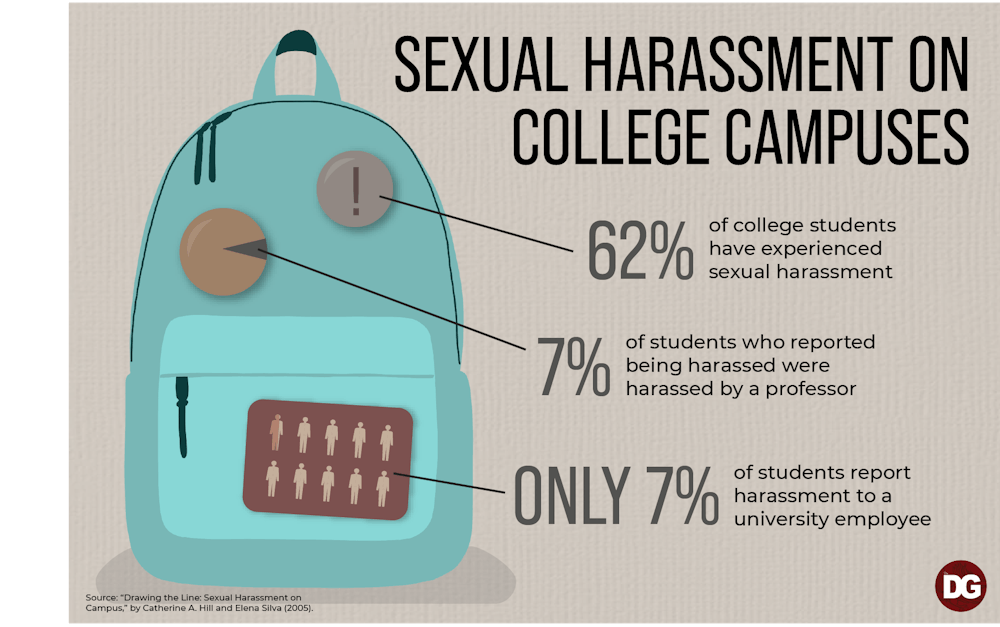The USC administration’s mishandling of sexual harassment allegations perpetrates a systemic crisis at this university.
Over the past few months, there’s been a renewed focus on sexual harassment at USC in the media and on campus. Lawsuits and reports allege that multiple professors have harassed and abused their female students and colleagues.
The examples are numerous: A student and two professors sued art professor David Voros for sexual harassment and misconduct. The lawsuits allege that he made unwanted sexual advances, forced his students into manual labor and then both threatened and carried out retaliation against the women who reported his abuse.
Theater professor Robert Richmond allegedly sent sexual texts to female students, allegedly got students drunk, showed up at student parties, made unwanted physical advances and hyper-sexualized his female students in theater productions.
Mike Dollar, associate vice president and the chief technology officer in the Division of Information Technology, allegedly forced a former systems administrator to get an abortion after the two started a sexual relationship. If she did not get an abortion, a lawsuit alleges, Dollar said he would fire her.
David Snyder, a history professor and the faculty principal of Maxcy College, allegedly cajoled an emotionally vulnerable student into a sexual relationship. After she cut off contact he sent her 184 emails, some of which were sexual.
Aside from being horrific and unacceptable, there’s another through line between all these allegations: USC’s administration knew about them, and did nothing. Actually, that’s not true — they did worse than nothing.
Instead of holding known abusers accountable, they protected the abusers and retaliated against survivors.
Instead of positively acting on the numerous formal complaints against Voros, the administration dismissed them. According to a lawsuit, Susan Bonn, one of President Bob Caslen’s advisers, asked a survivor to sign a document stating she had not experienced sexual assault.
Multiple School of Visual Art and Design chairs were also dismissive of the complaints: Current chair Laura Kissel allegedly told one survivor to “place crystals on her desk to make her feel safe,” and then-chair Peter Chametzky threatened another’s job.
The administration had copies of text messages Richmond sent to a student, which said “send a pic of your outfit,” “what are you wearing?” and “Good, I wanna see it. And take it off!!!!!”
Despite this hard evidence, they ruled that Richmond did not make any “unwelcome sexual advances, requests for sexual favors, verbal or other expressive behaviors or physical conduct commonly understood to be of a sexual nature.”
Dollar was reported to three people at USC, including human resources and an associate dean. Instead of holding him accountable for forcing one of his workers to get an abortion, the victim was stripped of her job duties. When she started crying in a meeting after being denied a victim’s advocate, one of her managers mocked her and took a picture of her crying, a lawsuit alleges.
Voros, Richmond and Snyder were temporarily removed from campus after public pressure, but giving abusers paid vacation is not holding them accountable.
There is frankly not enough room in one column to detail how extensively the administration has failed to keep its students and faculty safe. Responsibility does not just lie with former President Harris Pastides or Caslen; it stretches into the visual arts school, the theater department, human resources, IT and the Equal Opportunities Programs office, which is supposed to handle these sorts of allegations.
Unfortunately, these are just the instances which have been made public — it’s impossible to know how many departments, offices and individuals are actually involved. This is a systemic crisis in every sense of the term.
On March 14, Caslen sent out an email where he finally acknowledged this problem. The email laid out five “immediate next steps”: continuing an already existing Title IX workgroup, creating a new Title IX coordinator position and a new Case Review Committee and conducting some internal reviews.
It’s good that Caslen is finally doing something, but these “next steps” are just bureaucratic reshuffling. A new position here and a different committee there is not going to solve such a deep-seated issue.
The internal review will be led by a senior faculty member and an administrator, despite the fact the abuse is being perpetrated by senior faculty members and covered up by administrators in the first place. An investigation is definitely necessary, but it must be led from outside the university.
If Caslen’s administration wants to solve this problem, then its first step should be to fire every known abuser and everyone who helped cover up their actions. After that, Caslen and his administration should resign and be replaced by leadership who is willing to make deep systemic and cultural change.
Anything else is just PR.

